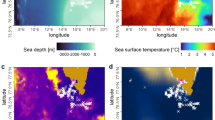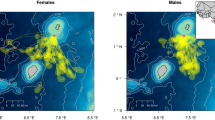Abstract
The foraging areas and diets of the grey-headed albatross Thalassarche chrysostoma and wandering albatross Diomedea exulans were studied in March/April 2000 at Bird Island, South Georgia, during their respective chick-rearing and brood-guard periods. Oceanographically, March/April 2000 was abnormal, with warm conditions close to South Georgia. These conditions affected albatross foraging behaviour, particularly that of grey-headed albatrosses. Both species tended to forage in different areas of the ocean, with significant differences in trip durations. Grey-headed albatrosses (n=9) foraged mainly in Antarctic waters (predominantly shelf waters of the South Shetland Islands and Antarctic Peninsula, and also in oceanic waters around South Georgia), feeding mainly on krill (Euphausia superba; 77% by mass). Foraging trips lasted 13.3 days (range: 5–26 days), far longer than the 1–3 days found in previous studies. Only one grey-headed albatross was associated with the APF (Antarctic Polar Front), a reported foraging area in recent studies. Wandering albatrosses (n=9) foraged in Antarctic (South Georgia Shelf) and Antarctic Polar Frontal Zone (APFZ) waters, with trips of 1–4 days trip duration (usual for this species), feeding on fish (46% by mass) and cephalopods (32%). One bird was associated with the APF, and two birds foraged on the shelf/shelf break over the Patagonian shelf. These findings suggest that sea surface temperature anomalies, produced by movement of the APF closer to South Georgia or by eddies, may have had an effect on the foraging strategy of grey-headed albatrosses that year (the main prey of grey-headed albatrosses in previous studies, the ommastrephid Martialia hyadesi, is known to be associated with the APF). Also, when both albatross breeding periods overlap, their foraging areas were complementary, which reflected the prey taken.





Similar content being viewed by others
References
Arnould JPY, Briggs DR, Croxall JP, Prince PA, Wood AG (1996) The foraging behaviour and energetics of wandering albatrosses brooding chicks. Antarct Sci 8:229–236
Atkinson A, Whitehouse MJ, Priddle J, Cripps GC, Ward P, Brandon MA (2001) South Georgia, Antarctica: a productive, cold water, pelagic ecosystem. Mar Ecol Prog Ser 216:279–308
Boltovskoy D (1999) South Atlantic zooplankton. Backhuys, Leiden
Cherel Y, Klages N (1998) A review of the food of albatrosses. In: Robertson G, Gales R (eds) Albatross biology and conservation. Surrey Beatty, Chipping Norton, pp 113–136
Cherel Y, Weimerskirch H (1999) Spawning cycle of onychoteuthid squids in the southern Indian Ocean: new information from seabird predators. Mar Ecol Prog Ser 188:93–104
Cherel Y, Weimerskirch H, Trouve C (2000) Food and feeding ecology of the neritic-slope forager black-browed albatross and its relationships with commercial fisheries in Kerguelen waters. Mar Ecol Prog Ser 207:183–199
Clarke MR (1986) A handbook for the identification of cephalopod beaks. Clarendon, Oxford
Croxall JP, North AW, Prince PA (1988) Fish prey of the wandering albatross Diomedea exulans at South Georgia. Polar Biol 9:9–16
Croxall JP, Hall AJ, Hill HJ, North AW, Rodhouse PG (1995) The food and feeding ecology of the white-chinned petrel Procellaria aequinoctialis at South-Georgia. J Zool (Lond) 237:133–150
Croxall JP, Prince PA, Reid K (1997) Dietary segregation in South Georgia seabirds. J Zool (Lond) 242:531–556
Croxall JP, Black AD, Wood AG (1999a) Age, sex and status of wandering albatrosses Diomedea exulans L. in Falkland Islands waters. Antarct Sci 11:150–156
Croxall JP, Reid K, Prince PA (1999b) Diet, provisioning and productivity responses of marine predators to differences in availability of Antarctic krill. Mar Ecol Prog Ser 177:115–131
Fischer W, Hureau J (1985) FAO species identification sheets for fishery purposes, southern ocean, CCAMLR Covention Area fishing areas 48, 58 and 88. FAO, Rome
González AF, Rodhouse PG (1998) Fishery biology of the seven star flying squid Martialia hyadesi at South Georgia during winter. Polar Biol 19:231–236
González AF, Trathan PN, Yau C, Rodhouse PG (1997) Interactions between oceanography, ecology and fishery biology of the ommastrephid squid Martialia hyadesi in the South Atlantic. Mar Ecol Prog Ser 152:205–215
Hecht T (1987) A guide to the otoliths of Southern Ocean fishes. S Afr J Antarct Res 17:2–87
Hooge PN, Eichenlaub B (1997) Animal movement extension to arcview ver. 1.1. Alaska Science Center—Biological Science Center, U.S. Geological Survey, Anchorage
Ichii T (2000) Krill harvesting. In: Everson I (ed) Krill: biology, ecology and fisheries. Blackwell, Oxford
Imber MJ (1992) Cephalopods eaten by wandering albatrosses (Diomedea exulans L.) breeding at 6 circumpolar localities. J R Soc NZ 22:243–263
Kock K-H (1992) Antarctic fish and fisheries. Cambridge University Press, Cambridge
Moore JK, Abbott MR, Richman JG (1997) Variability in the location of the Antarctic Polar Front (90°–20°W) from satellite sea surface temperature data. J Geophys Res 102:27825–27833
Orsi AH, Whitworth III T, Nowlin Jr WD (1995) On the meridional extent and fronts of the Antarctic Circumpolar Current. Deep-Sea Res 42:641–673
Prince PA (1980) The food and feeding ecology of grey-headed albatross Diomedea chrysostoma and black-browed albatross, D. melanophris. Ibis 122:476–488
Prince PA, Morgan RA (1987) Diet and feeding ecology of Procellariiformes. In: Croxall JP (ed) Seabirds: feeding ecology and role in marine ecosystems. Cambridge University Press, Cambridge, pp 135–171
Prince PA, Wood AG, Barton TR, Croxall JP (1992) Satellite-tracking wandering albatrosses Diomedea exulans in the South Atlantic. Antarct Sci 4:31–36
Prince PA, Croxall JP, Trathan PN, Wood AG (1998) The pelagic distribution of South Georgia albatrosses and their relationships with fisheries. In: Robertson G, Gales R (eds) Albatross biology and conservation. Surrey Beatty, Chipping Norton, pp 137–167
Prince PA, Weimerskirch H, Wood AG, Croxall JP (1999) Areas and scales of interactions between albatrosses and the marine environment: species, populations and sexes. In: Adams NJS, RH (eds) Proceedings of the 22nd ornithological congress. BirdLife South Africa, pp 2001–2020
Reid K (1996) A guide to the use of otoliths in the study of predators at South Georgia. British Antarctic Survey, Cambridge
Rodhouse PG (1991) Population structure of Martialia hyadesi (Cephalopoda: Ommastrephidae) at the Antarctic Polar Front and the Patagonian Shelf, South Atlantic. Bull Mar Sci 49:404–418
Rodhouse PG, White MG (1995) Cephalopods occupy the ecological niche of epipelagic fish in the Antarctic Polar Frontal Zone. Biol Bull (Woods Hole) 189:77–80
Rodhouse PG, Clarke MR, Murray AWA (1987) Cephalopod prey of the wandering albatross Diomedea exulans. Mar Biol 96:1–10
Rodhouse PG, Prince PA, Clarke MR, Murray AWA (1990) Cephalopod prey of the grey-headed albatross Diomedea chrysostoma. Mar Biol 104:353–362
Rodhouse PG, Arnbom TR, Fedak MA, Yeatman J, Murray AWA (1992) Cephalopod prey of the southern elephant seal, Mirounga leonina L. Can J Zool 70:1007–1015
Rodhouse PG, Prince PA, Trathan PN, Hatfield EMC, Watkins JL, Bone DG, Murphy EJ, White MG (1996) Cephalopods and mesoscale oceanography at the Antarctic Polar Front: satellite tracked predators locate pelagic trophic interactions. Mar Ecol Prog Ser 136:37–50
Schiavini A, Frere E, Gandini P, Garcia N, Crespo E (1998) Albatross–fisheries interactions in Patagonian shelf waters. In: Robertson G, Gales R (eds) Albatross biology and conservation. Surrey Beatty, Chipping Norton, pp 137–167
Spear LB, Ainley DG (1997) Flight speed of seabirds in relation to wind speed and direction. Ibis 139:234–251
Trathan PN, Murphy EJ (2002) Sea surface temperature anomalies near South Georgia: relationships with the Pacific El Niño regions. J Geophys Res 108 (C4). DOI 10.1029/2000JC000299
Trathan PN, Brandon MA, Murphy EJ (1997) Characterization of the Antarctic Polar Frontal Zone to the north of South Georgia in summer 1994. J Geophys Res 102:10483–10497
Williams R, McEldowney A (1990) A guide to the fish otoliths from waters off the Australian Antarctic Territory, Heard and Macquarie Island. ANARE (Aust Natl Antarct Res Exped) Res Notes 75:1–173
Wood AG, Naef-Daenzer B, Prince PA, Croxall JP (2000) Quantifying habitat use in satellite-tracked pelagic seabirds: application of kernel estimation to albatross locations. J Avian Biol 31:278–286
Xavier JC, Rodhouse PG, Purves MG, Daw TM, Arata J, Pilling G (2002) Distribution of cephalopods recorded in the diet of Patagonian toothfish (Dissostichus eleginoides) around South Georgia. Polar Biol 25:323–330
Xavier JC, Croxall JP, Reid K (2003a) Inter-annual variation in the diets of two albatross species breeding at South Georgia: implications for breeding performance. Ibis (in press)
Xavier JC, Croxall JP, Trathan PN, Rodhouse PG (2003b) Inter-annual variation in the cephalopod component of the diet of wandering albatross Diomedea exulans, breeding at Bird Island, South Georgia. Mar Biol 142:611–622
Acknowledgements
We would like to thank D. Roberts, N. Aspey, M. Jessop and M. Powell for assistance in the field and D. Briggs in Cambridge. G. Podestá, S. Colwell, R. Ladkin and T. Lachlan-Cope for providing the SST data. P. Rodhouse, M. Wells, S. Thorpe, K. Arnold and M. Meredith for the useful discussions on oceanography. K. Reid for help on the identification of fish otoliths. This research was supported by the Ministry of Science and Higher Education, Portugal (Fundação para a Ciência e a Tecnologia), by the British Antarctic Survey and by the University of Cambridge.
Author information
Authors and Affiliations
Corresponding author
Additional information
Communicated by J.P. Thorpe, Port Erin
Rights and permissions
About this article
Cite this article
Xavier, J.C., Croxall, J.P., Trathan, P.N. et al. Feeding strategies and diets of breeding grey-headed and wandering albatrosses at South Georgia. Marine Biology 143, 221–232 (2003). https://doi.org/10.1007/s00227-003-1049-0
Received:
Accepted:
Published:
Issue Date:
DOI: https://doi.org/10.1007/s00227-003-1049-0




